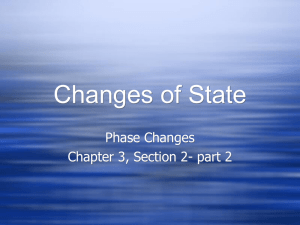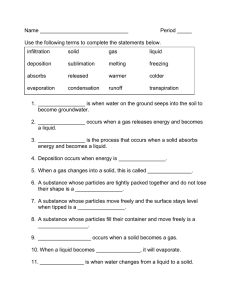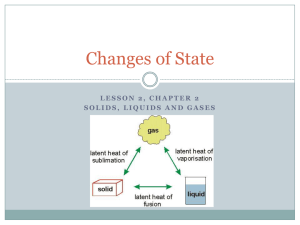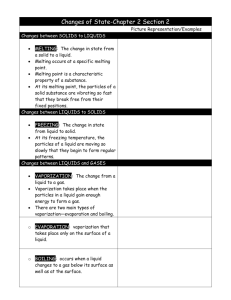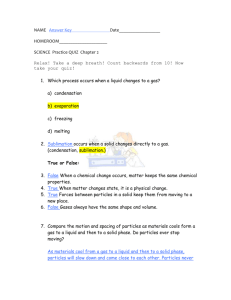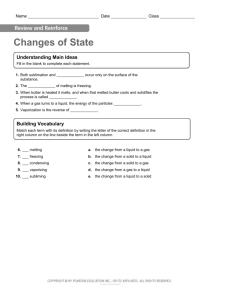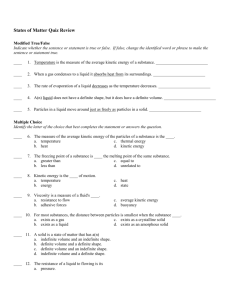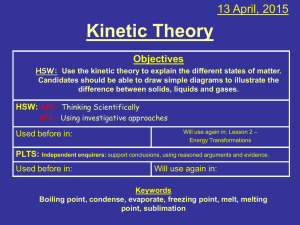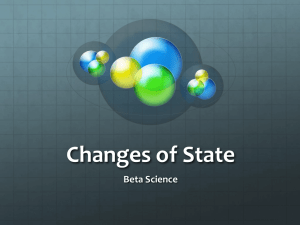Physical and Chemical Changes
advertisement
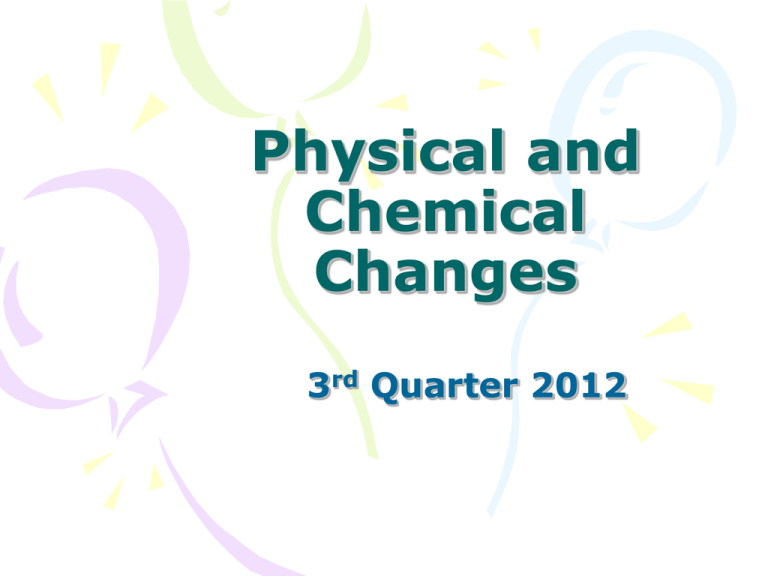
Physical and Chemical Changes 3rd Quarter 2012 Kinetic Theory of Matter THEORY OF KINETIC ENERGY A. ATOMS ARE ALWAYS MOVING B. THE MORE ENERGY ADDED TO THE ATOMS, THE FASTER & FARTHER APART THEY MOVE Physical Changes Matter is always changing form, size, shape, color, etc. There are 2 types of changes that matter undergoes. PHYSICAL OR CHEMICAL CHANGE I. Physical Changes: a change of matter without changing the identity of the substance. IN OTHER WORDS – A CHANGE IN STATE – A CHANGE IN SIZE, SHAPE, MASS – DOES NOT CHANGE THE CHEMICAL MAKE UP OF THE MATTER – YOU HAVE WHAT YOU STARTED WITH JUST IN A DIFFERENT FORM Examples of Physical Changes - Verbs used to describe physical changes – grind, dissolve, erode, rip, tear, break, phase change (melt, freeze, condense, etc) Other Physical Change Examples • PAPER TORN INTO PIECES –SUGAR DISSOLVED INTO TEA –SALT DISSOLVED INTO WATER –NAILS OR HAIR CUT Phase Changes are PHYSICAL PHYSICAL!!!!! • • • • • • • • Types of Phase Changes: 1. Melting 2. Freezing 3. Evaporization 4. Condensation 5. Sublimation 6. Deposition ALL phase changes are caused by ADDING or TAKING away energy!!! • MATTER CHANGES FROM ONE STATE OF MATTER TO ANOTHER –WHEN HEAT (ENERGY) IS ADDED –WHEN HEAT (ENERGY IS TAKEN AWAY DRAW THIS DIAGRAM IN YOUR NOTES!!!! • CHANGING STATES DOES NOT CHANGE THE CHEMICAL MAKE UP OF THE MATTER • YOU HAVE WHAT YOU STARTED WITH JUST IN A DIFFERENT FORM • ICE WATER WATER VAPOR • H 2O H 2O H 2O • WHEN MOLECULES MOVE FASTER, THEY PRODUCE MORE FRICTION AND THEREFORE MORE HEAT. THEY SPREAD FARTHER APART & EXPAND • WHEN MOLECULES MOVE SLOWER, THEY CAUSE LESS FRICTION AND THEREFORE LESS HEAT & CLOSER TOGETHER & CONTRACT Melting 1. MELTING – matter changing FROM A SOLID TO A LIQUID. – Energy is added – When more heat (energy) is added to matter the particles move faster till the bonds break. – Decrease density except ice to water. Evaporation/Vaporization 2. EVAPORATION – Matter changing FROM A LIQUID TO A GAS AT THE SURFACE – ENERGY IS ADDED TO SURFACE OF LIQUID – THE PARTICLES AT THE SURFACE MOVE FASTER breaking bonds. – Decreases density. • VAPORIZATION- a general term for any substance changing to a gas. Boiling 3. BOILING – matter changing FROM A LIQUID TO A GAS ALL THROUGHOUT THE LIQUID – ENERGY IS ADDED TO ALL OF LIQUID – PARTICLES MOVE FASTER ALL THROUGH THE LIQUID – SOME PARTICLES MOVE FAST ENOUGH TO CHANGE TO GAS WHILE THEY ARE IN THE MIDDLE OF THE LIQUID – DENSITY DESCREASES – Water boils at 212 F, 100C. • EX: pan of liquid on the stove • VAPORIZATION- a general term for any substance changing to a gas. VAPORIZATION!!! • Remember that vaporization is a general word for any substance changing to a gas. • Boiling, evaporation, and sublimation are ALL examples of vaporization!!! Condensation 4. CONDENSATION – Matter CHANGING FROM A GAS TO A LIQUID – ENERGY IS REMOVED • THE PARTICLES MOVE SLOWER • THE ATTRACTION BETWEEN THE PARTICLES BEGAN TO PULL THE PARTICLES CLOSER TOGETHER & THE MATTER TURNS INTO A LIQUID • DENSTITY INCREASES • Ex: dew in the lawn, water running down mirror, ring on table under glass. • FREEZING Freezing – CHANGING FROM A LIQUID TO A SOLID – ENERGY IS REMOVED • THE PARTICLES MOVE EVEN SLOWER • THE ATTRACTION BETWEEN THE PARTICLES BEGAN TO PULL THE PARTICLES CLOSER TOGETHER & THE MATTER TURNS INTO A SOLID • Increase density. • Water freezes at 32 F, 0 C • EX: water to ice, wax or chocolate hardening SOLIDIFICATION!!!! • Solidification is a general word for any substance changing to a solid. • Freezing and deposition are examples of SOLIDIFICATION! Sublimation • 5. Sublimation: matter changes straight from a solid to a gas!!!! • Heat added rapidly • Molecules speed up and spread out rapidly • decrease density • Examples of Sublimation: dry ice, shrinking ice in a freezer, air freshener. Deposition -Deposition- when matter changes from a gas directly to a solid. -Heat is taken away rapidly -Density increases -Molecules slow down and get closer together. Examples: Snowflakes, frost on a wind shield • WHAT HAS TO HAPPEN FOR THESE CHANGES OF STATES TO OCCUR? Bellringer 2: 1. All phase changes are: a. physical properties b. physical changes c. Chemical properties d. chemical changes 2. Condensation is: a. Liquid to gas b. Gas to solid c. Solid to gas d. gas to liquid Let’s Sing!!!! • • • • • • • • • • • • Phase changes are physical, physical… Melting is physical…. Freezing is physical. BOYS: Let me see some condensation. GIRLS: (in high pitch voice) It’s physical. BOYS: Let me see some sublimation. GIRLS: (in high pitch voice) It’s physical. Phase changes are physical, physical… Boiling is physical… Boiling is physical… BOYS: Let me see some deposition. GIRLS: (in high pitch voice) It’s physical BOYS: Let me see some evaporation. GIRLS: (in high pitch voice) It’s physical Chemical Changes The other way that matter can be changed is call a CHEMICAL CHANGE. occurs when 2 or more substances are combined into entirely new substance with all new properties. CANNOT CHANGE IT BACK!!!!! II. CHEMICAL CHANGE – Chemical Change Verbs • Chemical Change Verbs: rusting, rotting, curdling, burning, cooking, light sensitivity, digesting, tarnishing. Chemical Changes – SOME SIGNS OF A CHEMICAL CHANGE • FIZZES OR BUBBLES • COLOR CHANGE • HEAT GIVEN OFF • LIGHT GIVEN OFF • ODOR • HEAT REQUIRED FOR REACTION • NEW SUBSTANCE FORMED – Precipitate (solid) – Precipitate (gas bubbles) • CHEMICAL CHANGE EXAMPLES –BAKING BREAD – NO LONGER HAVE FLOUR, EGGS, MILK, YEAST –ALKASELTER –BAKING SODA & VINEGAR –RUST –TARNISH
